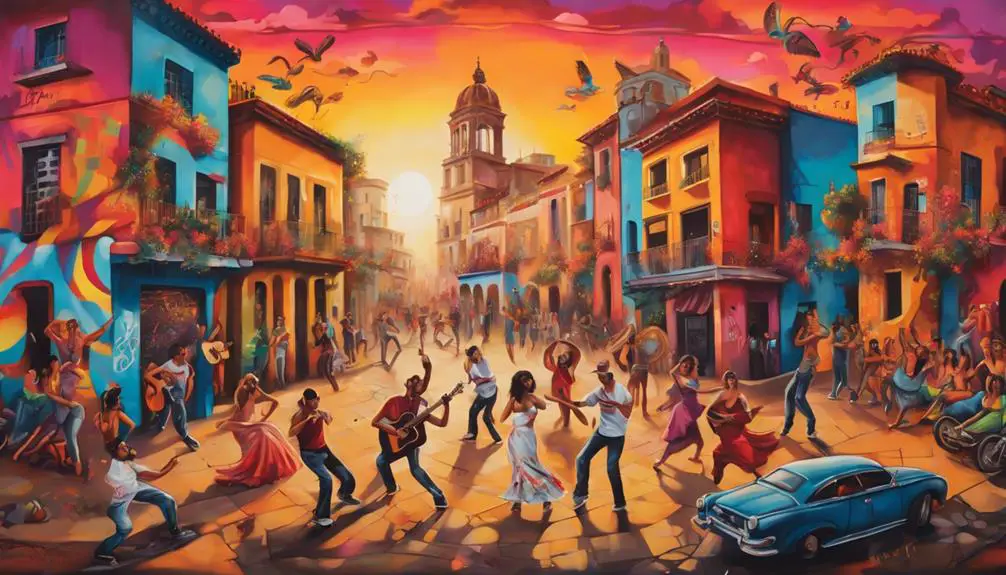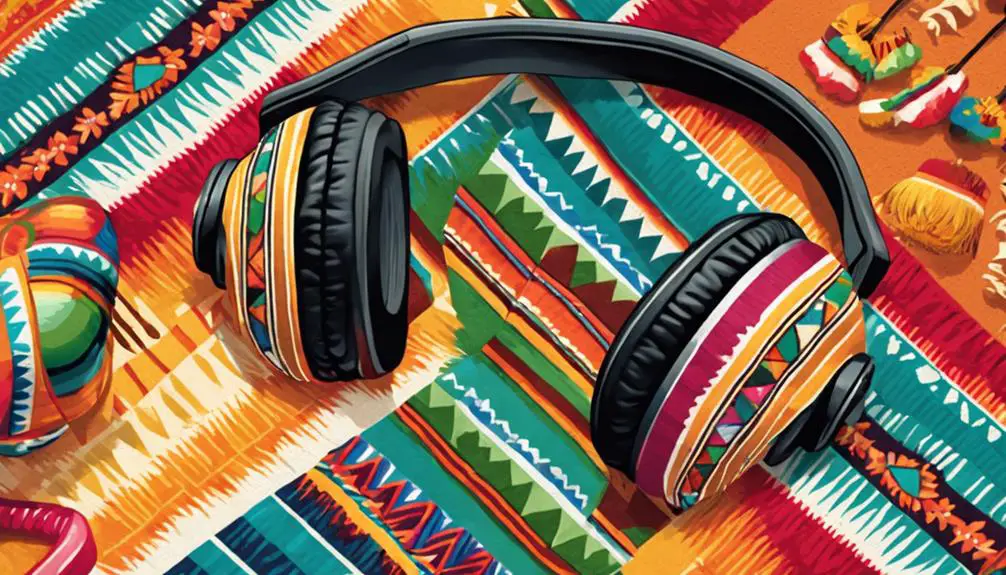When you tune in to Spanish-language media, you're not just listening to conversations – you're immersing yourself in a cultural tapestry woven from vibrant slang, rich history, and dynamic social dynamics. You'll discover how charismatic hosts bring personality to the mic, and how regional dialects shape the slang landscape in Latin America. Everyday conversations differ from formal language, and cultural immersion is key to understanding nuances of Spanish slang. As you explore further, you'll unravel the complexities of slang's impact on identity and get a glimpse into the fascinating world of Spanish slang.
Exploring Spanish Slang Culture

As you explore the vibrant world of Spanish slang, you'll uncover a cultural phenomenon that's deeply rooted in history, shaped by geography, and influenced by social dynamics.
Slang exploration has played a significant role in shaping the language, with new words and expressions emerging in response to cultural and social changes. For instance, African and indigenous influences have contributed to the development of unique slang terms in Latin America, reflecting the region's complex cultural heritage.
Cultural assimilation has also had a profound impact on Spanish slang, with words and phrases borrowed from other languages, such as English and French, being incorporated into everyday conversation. This blending of languages has resulted in a rich and dynamic slang culture that's constantly evolving.
As you investigate further into the world of Spanish slang, you'll discover a fascinating tapestry of cultural influences, historical events, and social movements that have shaped the language over time. By exploring this vibrant cultural phenomenon, you'll gain a deeper understanding of the complex social dynamics that underlie Spanish slang.
The Hosts Behind the Mic
Behind the mic, charismatic hosts are spinning Spanish slang into engaging narratives, often becoming cultural ambassadors who introduce listeners to the vibrant world of Latin American street language.
You'll notice that each host brings their unique personality to the mic, crafting a distinct atmosphere that draws you in. These mic personalities are the heart of the show, and their radio dynamics are what keep you tuning in.
From the energetic and lively to the smooth and laid-back, each host's style is a reflection of their own experiences and connections to the culture. As you listen, you'll pick up on the nuances of their delivery, the way they weave slang into conversations, and the infectious enthusiasm they bring to the topic.
It's this blend of charisma and expertise that makes the show feel like a conversation with a friend who's in the know. As you explore the world of Spanish slang, these hosts are your guides, making the journey both entertaining and enlightening.
Unraveling Slang in Latin America

You're about to embark on a fascinating journey to unravel the complexities of slang in Latin America, where diverse regions and cultures have given rise to a rich tapestry of expressions.
As you explore further, you'll discover that regional dialects have played a significant role in shaping the slang landscape. From the Caribbean coast to the Andean highlands, each region has its unique flavor of slang, reflecting the local culture, history, and identity.
You'll notice that slang evolution in Latin America is a dynamic process, influenced by factors like urbanization, migration, and globalization. For instance, the growth of urban centers has led to the emergence of new slang terms, blending indigenous, African, and European influences.
Meanwhile, the influx of migrants from rural areas has introduced rural slang into urban dialects, creating a fascinating fusion of languages and cultures.
As you explore the complexities of Latin American slang, you'll uncover a rich cultural heritage, woven from the threads of history, geography, and human experience. By understanding the regional dialects and slang evolution, you'll gain a deeper appreciation for the diversity and richness of Latin American cultures.
Conversations Beyond Textbooks
When you engage with native speakers, you'll find that everyday conversations in Latin America often stray far from the language taught in textbooks, revealing a more authentic, colloquial language that's shaped by local culture and history. This disparity highlights the language limits of traditional classroom instruction, which often focus on standardized, formal language. In contrast, real-life conversations are peppered with slang, idioms, and regional expressions that are rarely found in textbooks.
To truly grasp the nuances of Spanish slang, cultural immersion is key. Spend time with locals, participate in everyday conversations, and engage with popular culture to gain a deeper understanding of the language. This approach will help you pick up on the subtleties of informal language, including tone, context, and implied meaning.
The Impact of Slang on Identity

One of the most fascinating aspects of slang is its profound impact on shaping your identity, as the words and phrases you use can signal your affiliation with a particular group, region, or cultural movement. When you use slang, you're not just expressing yourself – you're also announcing your belonging to a specific community. This language belonging can be incredibly important, as it allows you to connect with like-minded individuals and feel a sense of authenticity.
Slang authenticity is essential, as it's often a badge of honor to be 'in the know' when it comes to the latest phrases and expressions. Using slang correctly can make you feel like you're part of an exclusive club, where you share a secret language with others.
However, misusing slang can have the opposite effect, making you appear inauthentic or even pretentious. As you navigate the world of Spanish slang, remember that the words you choose can have a profound impact on how others perceive you and how you perceive yourself. By using slang confidently and authentically, you can tap into a sense of language belonging that can be incredibly empowering.
Frequently Asked Questions
Is Spanish Slang Different in Various Latin American Countries?
You might wonder if Spanish slang differs across Latin American countries. The answer is yes, it does. Regional dialects play a significant role in shaping local slang, reflecting cultural identity and historical influences.
For instance, Mexico's 'chilango' slang is distinct from Argentina's 'lunfardo' or Cuba's 'habanero' dialects. Each country's unique cultural identity is reflected in its slang, making it diverse and fascinating.
Can Non-Native Speakers Use Slang to Sound More Fluent?
When you're trying to sound more fluent in Spanish, using slang can be a double-edged sword. While it's tempting to throw in some trendy phrases, authenticity matters.
If you're not familiar with the cultural context, you might come across as trying too hard or even offensive. Instead, focus on cultural immersion – surround yourself with native speakers, watch TV shows and movies in Spanish, and practice consistently.
This way, you'll naturally pick up slang and sound more natural, rather than forced.
Are There Any Formal Rules for Using Spanish Slang?
When it comes to using Spanish slang, you might wonder if there are any formal rules to follow.
The truth is, there isn't a centralized Slang Governance body regulating its use. However, there's an unspoken Slang Etiquette that native speakers tend to follow.
It's more about being mindful of your audience, context, and cultural nuances. You'll likely pick up on these subtleties as you immerse yourself in the language and culture.
Can I Learn Spanish Slang From Watching TV Shows or Movies?
As you tune in to your favorite Spanish TV shows or movies, you're wondering if they can teach you slang. The answer is yes, but with a twist. You'll get authentic exposure to conversational language, but language accuracy is vital.
Cultural immersion is essential, so don't just watch – listen, repeat, and practice. You'll pick up nuances and idioms, but be mindful of regional differences.
With dedication, you'll be speaking like a native in no time.
Is Spanish Slang Used More in Informal or Formal Settings?
Understanding Spanish slang is crucial when you want to grasp it, as it's commonly used in specific settings. Slang is more commonly found in informal environments, like casual get-togethers with friends or family, where cultural norms are less strict.
On the other hand, formal situations, such as business meetings or official events, usually maintain a more serious tone that aligns with the social hierarchy.
Conclusion
You've just scratched the surface of the vibrant world of Spanish slang! With millions of words waiting to be uncovered, your journey has only just begun.
From the streets of Buenos Aires to the bars of Barcelona, every region has its own secret language, and you're now equipped to decipher it.
Buckle up, because the world of español is about to get a whole lot more interesting!







